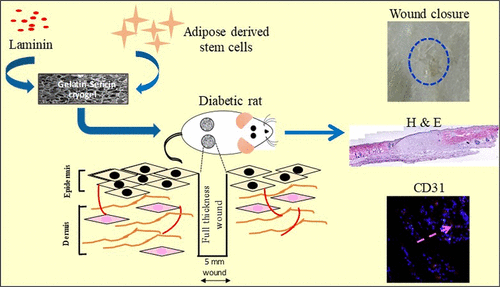当前位置:
X-MOL 学术
›
Biomacromolecules
›
论文详情
Our official English website, www.x-mol.net, welcomes your
feedback! (Note: you will need to create a separate account there.)
Adipose-Derived Stem Cells (ADSCs) Loaded Gelatin-Sericin-Laminin Cryogels for Tissue Regeneration in Diabetic Wounds.
Biomacromolecules ( IF 5.5 ) Pub Date : 2019-12-11 , DOI: 10.1021/acs.biomac.9b01355 Suhela Tyeb , Parvaiz A Shiekh , Vivek Verma , Ashok Kumar
Biomacromolecules ( IF 5.5 ) Pub Date : 2019-12-11 , DOI: 10.1021/acs.biomac.9b01355 Suhela Tyeb , Parvaiz A Shiekh , Vivek Verma , Ashok Kumar

|
Healing in wounds like pressure ulcers, diabetic ulcers, venous ulcers, and arterial insufficiency ulcers is immensely hampered and causes both an economic burden and morbidity to patients. These wounds face a plethora of hostile conditions like elevated reactive oxygen species (ROS), impaired angiogenesis, senescent fibroblasts, and deficient stem cells that significantly diminish the probability of self-healing in these wounds. Adipose-derived stem cell therapy (ADSC) presents a promising approach to achieve efficient healing in such cases. To address the complex scenario of chronic wounds, we propose a combinatorial approach of delivering ADSCs on antioxidant gelatin-sericin (GS) scaffolds coated with laminin (GSL), an endothelial basement protein to improve angiogenesis. The synthesized GS scaffolds showed values of compression modulus, pore size, porosity, and the swelling ratio in the range of 65 kPa, 158 ± 48.8 μm, 91.1% ± 1.25, and 28 ± 2.5, respectively. A DPPH assay revealed GS scaffolds exhibit around 20% more scavenging as against gelatin (G) scaffolds and better protection against free radical assault, thus enhancing cell viability and the metabolic index of fibroblast cells. Different cells, namely, fibroblasts, keratinocytes, and ADSCs, cultured on GS scaffolds had better metabolic activity as compared with G scaffolds. Laminin coating onto the scaffolds leads to improved attachment and tube formation of endothelial cells as depicted in scanning electron microscopy images. Finally, we validated the applicability of the ADSCs loaded laminin-coated GS scaffolds in a diabetic ulcer rat model. Hematoxylin and eosin, Masson's trichrome, and picrosirius red staining showed better regeneration and collagen remodeling in ADSCs loaded GSL scaffolds. Immunostaining of CD31 staining demonstrates enhanced angiogenesis in GSL-ADSC as compared with other groups.
中文翻译:

脂肪衍生的干细胞(ADSC)负载明胶-丝氨酸-层粘连蛋白冰晶,用于糖尿病伤口的组织再生。
诸如压力性溃疡,糖尿病性溃疡,静脉性溃疡和动脉供血不足性溃疡等伤口的愈合受到极大的阻碍,并给患者带来经济负担和发病率。这些伤口面临着许多不利条件,例如活性氧(ROS)升高,血管生成受损,衰老的成纤维细胞和干细胞不足,这些都大大降低了这些伤口自我修复的可能性。脂肪干细胞疗法(ADSC)提供了一种在此类情况下实现有效治愈的有前途的方法。为了解决慢性伤口的复杂情况,我们提出了一种在涂有层粘连蛋白(GSL)的抗氧化剂明胶-丝氨酸(GS)支架上递送ADSC的组合方法,所述层粘连蛋白是一种改善血管生成的内皮基底蛋白。合成的GS支架显示出压缩模量值,孔径,孔隙率和溶胀率分别在65 kPa,158±48.8μm,91.1%±1.25和28±2.5范围内。DPPH分析显示,与明胶(G)支架相比,GS支架的清除能力高出约20%,并且对自由基的攻击具有更好的保护作用,从而增强了细胞活力和成纤维细胞的代谢指数。与G支架相比,在GS支架上培养的不同细胞,即成纤维细胞,角质形成细胞和ADSCs具有更好的代谢活性。如在扫描电子显微镜图像中所描绘的,层粘连蛋白涂层在支架上导致内皮细胞的附着和管形成的改善。最后,我们验证了装载有层粘连蛋白涂层的GS支架的ADSCs在糖尿病性溃疡大鼠模型中的适用性。苏木和曙红,马森三色,Picosirius红色染色显示,在装有GSL支架的ADSC中,再生和胶原重构更好。与其他组相比,CD31染色的免疫染色证明了GSL-ADSC中增强的血管生成。
更新日期:2019-12-11
中文翻译:

脂肪衍生的干细胞(ADSC)负载明胶-丝氨酸-层粘连蛋白冰晶,用于糖尿病伤口的组织再生。
诸如压力性溃疡,糖尿病性溃疡,静脉性溃疡和动脉供血不足性溃疡等伤口的愈合受到极大的阻碍,并给患者带来经济负担和发病率。这些伤口面临着许多不利条件,例如活性氧(ROS)升高,血管生成受损,衰老的成纤维细胞和干细胞不足,这些都大大降低了这些伤口自我修复的可能性。脂肪干细胞疗法(ADSC)提供了一种在此类情况下实现有效治愈的有前途的方法。为了解决慢性伤口的复杂情况,我们提出了一种在涂有层粘连蛋白(GSL)的抗氧化剂明胶-丝氨酸(GS)支架上递送ADSC的组合方法,所述层粘连蛋白是一种改善血管生成的内皮基底蛋白。合成的GS支架显示出压缩模量值,孔径,孔隙率和溶胀率分别在65 kPa,158±48.8μm,91.1%±1.25和28±2.5范围内。DPPH分析显示,与明胶(G)支架相比,GS支架的清除能力高出约20%,并且对自由基的攻击具有更好的保护作用,从而增强了细胞活力和成纤维细胞的代谢指数。与G支架相比,在GS支架上培养的不同细胞,即成纤维细胞,角质形成细胞和ADSCs具有更好的代谢活性。如在扫描电子显微镜图像中所描绘的,层粘连蛋白涂层在支架上导致内皮细胞的附着和管形成的改善。最后,我们验证了装载有层粘连蛋白涂层的GS支架的ADSCs在糖尿病性溃疡大鼠模型中的适用性。苏木和曙红,马森三色,Picosirius红色染色显示,在装有GSL支架的ADSC中,再生和胶原重构更好。与其他组相比,CD31染色的免疫染色证明了GSL-ADSC中增强的血管生成。











































 京公网安备 11010802027423号
京公网安备 11010802027423号